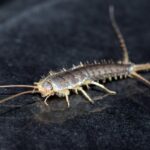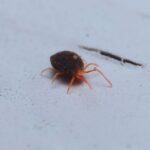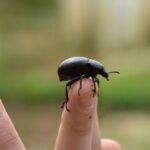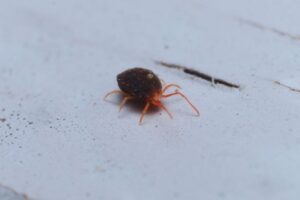If it seems like you have nasal issues or allergy attacks every time you are in bed, chances are that there are small bugs in your bed. So, what are these tiny white bugs in your bed?
The tiny white bugs in your bed are young bed bugs, also known as nymphs. They are typically white or yellow. If these bugs have not yet eaten, their translucent body can be unnoticeable to the naked eye. However, the tiny white bugs that jump on the bed are called springtails, while the ones that bite are called whiteflies.
Read on to learn more about these tiny white bugs in the bed and know how to get rid of them.
Tiny White Bugs in Bed – What Are They and How to Get Rid of Them

The small white bugs in your bed are also known as nymphs. They are young bed bugs and are typically white or yellow.
If these bugs are not fed, their translucent body can be undetectable to the naked eye. But the tiny white bugs that bite are called whiteflies, while the ones that jump on the bed are called springtails.
What Are Nymphs?
Nymphs are young bed bugs. It is the first stage of the life cycle of the Cimex lectularius. Each bed bug egg, in essence, measures as small as a pinhead. It is pearl white and can be identified by its eyespot.
Tiny White Bugs That Jump on My Bed
If you notice tiny white bugs jumping on your bed, they are most likely springtails. Springtails form part of the Collembola family. They are about 6 mm in length, and their color varies.
Suffice it to say that not all springtails are white. Some are bluish purple, gray, or brown. There are even opalescent or shimmering springtails.
While all springtails can jump, their legs have nothing to do with this ability. Instead, it has something to do with their spring-loaded mechanism referred to as furcula. The furcula locks on their bodies’ undersides which, if moved or disturbed, causes these bugs to jump.
Tiny White Bugs in Bed That Bite
If you are curious about the tiny white bugs in bed that bite, they are most likely whiteflies. They look like lint, bite people, and tend to bite repeatedly.
Their bite is not poisonous but can be more painful than mosquito bites. This can then lead to irritated skin-like rashes. Also, people with allergies can experience more severe reactions.
It is nearly impossible to spot whiteflies in the garden or greenhouse. These oblong-shaped insects are usually on the underside of plant leaves, making it difficult for people to notice them immediately.
Unfortunately, this type of insect does not only bite, but it kills plants too. They tend to inject saliva into leaves, which sadly damages plants.
How to Identify Bed Bugs
Bed bugs are pests that commonly feed on blood. Their bites often lead to irritated skin or allergies. Unfortunately, they are a public health pest that can spread diseases.
Young bed bugs often appear white. They are typically unnoticeable, especially when they have not yet been fed. In which case, their bodies become translucent. Some retain their color as they become adults, while some color change.
Here are the general characteristics of an adult bed bug:
- Brown in color and oval-shaped when not fed
- Reddish brown in color and elongated when fed
- It has a musty and sweet smell
- About 6 mm in size
- Has wings but does not fly
- Hair is short and golden
- The antenna has four parts
- Beak features three segments
Where Do Bed Bugs Hide
If you have no idea what causes your irritated skin or rashes, chances are that there are bed bugs in your home.
Here is a list of areas where bed bugs usually lurk:
- Inside duvet covers or beddings
- Tags, seams, and piping of the box spring or mattress
- Electrical receptacles or appliances
- Drawer joints
- Rugs or carpets
- Baseboard cracks
- Wall-wall or ceiling-wall junction points
- Beneath loose wallpapers or wall hangings
- In pillows and cushions
- Couch or chair seams
- Screwheads
- Headboard and bedframe cracks
Bed bugs are typically tiny and undetectable. Suffice it to say that if you are figuring out if there are bed bugs in your home, do not look for the bugs. Instead, look for signs.
For instance, check if there seem to be tiny rusty stains or smudges on the bed sheet, which are common when bed bugs are crushed. You can also check for tiny dark spots on any fabric in your home.
How to Get Rid of Whiteflies

There are several ways of getting rid of whiteflies. Here are some of them:
- Use Spray Bottle or Watering Hose to Blast Whiteflies
- Spray Plants with Insecticidal Soap
- Create Your Spray Mixture
- Use Handheld Vacuum Cleaner
Let’s briefly discuss each one of them:
1. Use Spray Bottle or Watering Hose to Blast Whiteflies
You can blast off whiteflies using water. Make sure to use a spray bottle or a watering hose to do this conveniently. Blasting them off with water will scatter them and displace nymphs and eggs.
2. Spray Plants with Insecticidal Soap
You may also use insecticidal soap to get rid of whiteflies. Follow the manufacturer’s instructions written on its packaging. Also, make sure to apply insecticidal soap on the undersides of the leaves. Repeat the process three times.
Spraying plants at nighttime is more ideal than doing it during the daytime. This is because the temperature is cooler in the evening. Spraying during the daytime under the sun’s heat might result in an adverse reaction and damage your plants.
3. Create Your Spray Mixture
You can prepare a mixture at home, which is also recommended by the National Gardening Association (NGA). This is so simple that all you need are a squirt of dish soap and a gallon of water.
This mixture is best sprayed during nighttime or late afternoon, or when there is a cool temperature.
4. Use Handheld Vacuum Cleaner
You can use a handheld vacuum cleaner if the first three methods are ineffective. Carefully vacuum plant surfaces to get rid of bed bugs. However, ensure not to empty your vacuum into a garbage can carefully. Make sure to dispose of it responsibly.
Again, what are the tiny white bugs in bed? Nymphs or young bed bugs are usually the white bugs you can find in the bed. They can be yellow too. Their translucent body makes it impossible to see when they haven’t eaten.
How Can You Get Rid of Bed Bugs?
You can apply a nonchemical or chemical approach when getting rid of bed bugs. Whatever you choose, it is worth noting that getting rid of bed bugs requires time and patience.
Suffice it to say that spraying insecticidal soap once will not do the trick. That’s why many homeowners consider seeking professional help to solve the problem.
However, there are several things you can do on your own:
- Evaluate the Situation
- Space Preparation
- Alertness
Let’s briefly tackle them:
1. Evaluate the Situation
If you have a hunch that there are bed bugs in your home, confirm this by assessing the situation. That way, you can explain everything should you seek professional assistance.
As earlier mentioned, check for signs that there are indeed bed bugs. Are there rusty stains or smudges on your fabric? Or are there dark spots on it? These are indications that some bed bugs have been crushed.
Once you have confirmed the presence of bed bugs in your home, it is time to decide whether to apply a nonchemical or chemical approach to get rid of them. It is important to note, too, that both methods have pros and cons.
For instance, while a nonchemical spray may be safe for your health, it may not be very effective in removing bed bugs. You might find it frustrating, especially if looking for immediate results.
On the contrary, it is possible to get immediate results using a chemical approach. However, severe chemicals might harm your health.
My advice is to weigh all the pros and cons. Then, choose the one that has a lesser negative impact on your health.
2. Remove the Uninfested Things Out of the House
Preparing the space infested with bed bugs is part of the process. To conveniently spray a chemical or nonchemical insecticide, you might have to remove or keep some of your things out of your home.
Typically, you have to store your food elsewhere safely. Or, you might have to look for a place where you and your family can temporarily stay.
Some homeowners choose to replace their mattresses and bedding. Some also choose to fix the cracks on walls and their furniture. In some cases, homeowners choose to replace their furniture too. Whatever you choose, it is important to be financially prepared for this too.
3. Alertness
Stay alert even after implementing the treatment plan. Remember that bed bugs tend to re-emerge. This is especially true if your treatment plan is to replace the old bedsheets with clean ones.
Frequently Asked Questions – What Are Tiny White Bugs in Bed?

Here are some frequently asked questions concerning tiny white bugs in bed:
Are White Mites Harmful?
White mites do not bite and do not cause structural damage; that’s why they are typically considered harmless. But in reality, they can be harmful too. They often shed long hairs that carry allergens which can cause allergic reactions.
What Are Those Tiny White Bugs?
The small white flying bugs present in your home are whiteflies. They are related to mealybugs and aphids. They are tiny, but their size depends on which species they belong to. Unfortunately, whiteflies infest and damage plants.
Are White Mites Bed Bugs?
White mites and bed bugs are different creatures, but they are both pests. Both white mites and bed bugs can infest our homes and bodies. They can make our lives difficult and can even cause anxiety and stress to some.
How Do I Get Rid of Little White Bugs?
To eliminate the little white bugs in your home, start by blasting them with water using a spray bottle or a watering hose. Doing so will scatter them and somehow displace the nymphs and eggs.
You can also use insecticidal soap or a homemade mixture approved by the National Gardening Association (NGA). If all the methods you have applied seem ineffective, it is time to seek professional help.
Do White Mites Bite Humans?
White mites or dust mites do not live on humans, and they do not bite too. However, the proteins in their exoskeletons and feces can result in human allergic reactions. Patches of red bumps may be caused by exposure to mites. This is typically followed by sneezing and nasal congestion.
What Bugs Look Like White Lint?
The bugs that look like white lint are called mealybugs. They are tiny white bugs that typically stay inside houses. Due to their size, they go undetectable most of the time. They stay in gardens too and live on plants.
How Do I Know If I Have Bed Mites?
Several signs indicate that bed mites are infesting your place. Some of these are the blood stains on pillowcases or bed sheets, the musty smell coming from their scent glands, and bed bug egg shells and fecal spots.
What Are These White Things on My Bed?
The white things you see on your bed are most likely bed bug eggs. They are elongated, semi-transparent, and typically resemble a grain of rice.
Bed bug eggs are so tiny, but you can identify them since they are commonly clustered together. You can use a flashlight to spot them between cushions, behind headboards, and in other areas.
Can Adult Bed Bugs Be White?
Full-grown adults are not white. Instead, they are reddish brown with flat bodies measuring about ¼ inch in length. They resemble the size of an apple seed.
Young bed bugs are the white ones. They are almost colorless. When these bed bugs feed on blood, their bodies swell and turn bright red. They typically measure 1/16 inches in length.
How Long Do White Mites Live?
Typically, the lifespan of adult mites ranges between two and four weeks. During their lifespan, they can lay hundreds of eggs. They have a rapid reproduction rate that even a small colony can multiply in weeks.
How Do I Get Rid of White Mites Naturally?
You can make your insecticide to get rid of white mites naturally. A do-it-yourself (DIY) solution includes a gallon of water and five tablespoons of dishwashing liquid. You may also use a pure soap like castile soap. Spraying this will not pose any harmful effects on plants.
What Kills Mites Instantly?
Expect to immediately eliminate mites when you spray aerosols and sprays containing pyrethrins on them. However, this solution remains effective only for a few hours. If you want an insecticide that remains effective for weeks, try those with bifenthrin or permethrin.
Can Bed Bugs Be Tiny?
Bed bugs are tiny. They are flat and wingless insects that measure about one-quarter inch in length. Adult bed bugs are reddish brown, while the young ones are white or almost colorless.
What Could Be Mistaken for Bed Bug?
Carpet beetles could be mistaken for bed bugs. They are a type of household pest the same size as bed bugs. Carpet beetles are also common in homes; some have black or brown shells.
What Smell Attracts Bed Bugs?
There are several types of smells that attract bed bugs into your home. Some of these are scented candles, Windex, fabric softener, and bleach.
Where Do Bed Bugs Hide on Your Body?
Bed bugs can be anywhere on your body. However, the bites on our ankles and feet are the most common. Interestingly, bed bug bites seem to appear in a consistently straight pattern. Bed bug bites are also common on the arms, neck, and face.
How Do Small Bed Bugs Look?
Bed bugs are brownish insects that are tiny and elongated. They live on the blood of both humans and animals. Typically, they are as small as an apple seed and have flat bodies. Once they are fed, their bodies start to swell and turn reddish.
Do Bed Bugs Bite Every Night?
Bed bugs tend to bite several times a night to become full. However, they feed themselves only once every one to two weeks.
In Closing: Tiny White Bugs in Bed – What Are They and How to Get Rid of Them?
Small white bugs in your bed are also known as nymphs. They are young bed bugs and are typically white or yellow.
If these bugs are not fed, their translucent body can be undetectable to the naked eye. But the tiny white bugs that bite are called whiteflies, while the ones that jump on the bed are called springtails.
There are several ways of getting rid of white bed bugs at home. There are chemical and nonchemical approaches. Also, there are DIY solutions you can use, and those you can buy in physical or online retail stores.
You also have the choice to spray the insecticide on your own. But if you are hesitant to do this, you can always seek professional services.


![Tiny Bugs in Bed [Not Bed Bugs] - What Are They? Tiny Bugs in Bed](https://homecarezen.com/wp-content/uploads/2022/01/tiny-bugs-in-bed-150x150.jpg)






